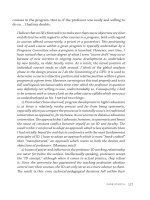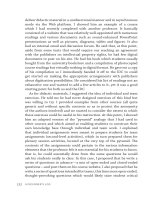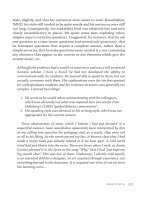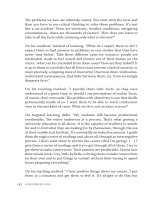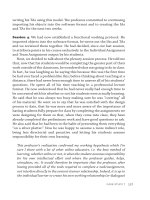A Designer’s Log Case Studies in Instructional Design- P29 pot
Bạn đang xem bản rút gọn của tài liệu. Xem và tải ngay bản đầy đủ của tài liệu tại đây (76.24 KB, 5 trang )
127
CASE STU DY 6
courses in the program, that is, if the professor was ready and willing to
do so… I had my doubts.
I believe that an ID’s rst task is to make sure that course objectives are clear
and distinctive with regard to other courses in a program, both with regard
to courses oered concurrently, a priori or a posteriori. is positioning
task of each course within a given program is typically undertaken by a
Programs Committee when a program is launched. However, over time, I
have noticed that a certain degree of what I term “course drift” may occur
because of new currents in ongoing course development as undertaken
by new faculty, as older faculty retire. As a result, the actual position of
individual courses tends to shift around. I think of the global analysis
phase in the design process as I do the functioning of a GPS: it is used to
determine a course's objective position and relative position within a given
program at a given time. However, carrying out this task properly and to its
full and logical conclusion takes time, time which the professor in question
was denitely not willing to lose, understandably so. Consequently, I had
to be content with a cursory look at the other course syllabi which were just
as underdeveloped as his. I noticed two things:
1) From what I have observed, program development in higher education
is at times a relatively murky process and far from being systematic,
especially when you compare the process as it naturally occurs in traditional
universities as opposed to, for instance, its occurrence in distance education
universities. e approach that I advocate, however, is systematic and hence
the cause of constant conict between myself as an ID and faculty. e
result is this: I am forced to adopt an approach which is less systematic than
I had initially hoped for and less in conformity with the most fundamental
principles of ID. I have to adopt an approach which is more “hand-crafted”
than “manufactured,” an approach which reacts to both the desires and
objections of professors. (Mamma mia!)
2) Issues of power and inuence in the professor-ID working relationship
are never far below the surface. Intellectually speaking, professors accept
the “ID concept,” although when it comes to actual practice, they refuse
it. Since the university has guaranteed the teaching profession absolute
control over their courses, the ID can only serve as a mere advisor to them.
e result is this: even technical-pedagogical decisions fall within their
A D ESI G N E R ' S LO G
128
jurisdiction. e ID is thus relatively limited in his ability to carry out the
design process in a rigorous, systematic manner.
Consequently, the end-product of design will necessarily be a compromise
between how much professors are willing to contribute (i.e. in terms of
time and eort) and what the ID considers as a bottom-line. Once again, I
observed that an instructional design model such as that proposed by Dick
and Carey is not at all applicable in the university context because time, i.e.
adequate time for design is simply not available. And it likely never will be.
We completed the analysis of the other course syllabi and were ready to
begin using the horizontal course syllabus (HCS) grid to design his course.
At this point, the professor asked me to explain, once again, the means of
course delivery available to him. Obviously, he was interested in talking
about any other subject than design. I briey answered his questions and
tried to bring him back to discussing his course syllabus, which we then
slowly proceeded to examine. His typical practice was to provide readings
to his students (in the form of a photocopied compilation) which they
were to study before coming back into class. is discussion of his course
material appeared to interest him and, since it could potentially open up
the door to our discussing design matters, I seized upon it and we then
began looking at his texts. (I decided not to talk about objectives for the
time being as I intuitively knew it would be a touchy subject.)
I asked him about how he divided up his readings from week to week,
since a distribution pattern did not appear in the syllabus. He told me that
he would typically inform students, one week at a time, which readings
were to be done but he said he had never actually taken note of the exact
sequence. I explained that, in distance teaching, having more structure (I
avoided the term “order”) had proven to be benecial, especially in light
of his wish to minimise e-mail trac and telephone exchanges between
plenary sessions. ere was a price to pay, however, for this expedience:
his expectations and requirements would have to be specied in his
course syllabus. Sequencing readings according to a course outline would
mean that we would have to redene his syllabus in terms of weekly
themes and assignments. From a rst glance, it appeared that he had a
signicant number of texts for some themes and only a few for others.
Was this imbalance due to certain themes having more importance than
others or simply because he simply had more material available to cover
129
CASE STU DY 6
them? We looked over his themes again and identied the course’s sub-
themes, which allowed us to delve deeper and deeper into the very heart
of his course. As he spoke to me about the linkage between themes, I
discretely started taking note of the specic objectives that emerged. I
intended to discuss this with him later on. For the moment however, we
focussed on identifying and sequencing the themes and sub-themes, as
well as associating readings with each.
I asked him about how he covered the readings in class. He told me
that the readings provided students with the basic concepts of a given
theme and that he elaborated on them during the plenary session by way
of lecturing but mostly by on-the-spot questioning (using the Socratic
question and answer method). He said that he relished putting students
on the spot, that it was good for their minds. I asked him if he had any
personal notes on his presentations and he did have some rough notes
and key sentences that he kept in a notebook but he emphasized that his
classes were largely spontaneous events, as were the questions he asked
his students. Being extremely familiar with his readings, indeed, having
written some of them himself, questions came to him automatically.
He also explained that his follow-up questions varied according to the
answers he got from students. If he detected an error in a student’s logic
or a lack of understanding of a given concept, he would reformulate the
question and then ask another student to determine whether the error
was unique to a given student, whether it was in his wording or whether
it was a commonly-shared misconception. If, indeed, it turned out to be
shared, he would go back over the topic in question and clarify matters. If
it was an individual problem, he would usually just tell the student where
he or she could nd the appropriate information on the subject and then
move on with his presentation.
is approach seems quite typical in higher education, at least in certain
faculties, and is considered to be, quite rightly in my opinion, a major
strength of the on-campus university teaching tradition: the withering
interrogation followed by the exaltation of getting it right or the shame of
publicly going down in ames, only to arise again from one’s own ashes during
the next class. e challenge is this: how to reproduce, or simulate this in
distance teaching? In thinking this issue over, I recognized the importance,
once again, of the role of dialogue in the construction and sharing of
A D ESI G N E R ' S LO G
130
knowledge. Socio-constructivists claim that knowledge acquisition must
go through the crucial stage of negotiated meaning. Knowledge does not
exist in and by itself, but only the mental representation that one makes
of it. What a student cannot represent mentally will never truly become
acquired knowledge. An environment which encourages the negotiation of
meaning is one in which students can converse openly and directly with
both their professors and among themselves. If the classroom model is the
ideal model, and if the on-campus classroom is to be simulated, then the
classroom in virtual space must be recreated in a way that oers the same
dialogue and information sharing possibilities. is is exactly what we
were hoping the virtual classroom (the synchronous platform with which
we are experimenting) would be able to do.
Predictably, the professor returned to the issue of course delivery, so we
began talking about the synchronous platform and the results the team
had been getting. Up to this point, none of the professors had used it in
their teaching, and only some of them had participated in tests using
it, mostly because of the agreement that had been reached between the
Continuing Education Service, our corporate sponsor/videoconferencing
service provider and its client groups, essentially requiring that all
courses be delivered via videoconferencing (VC). However, as mentioned
at the outset of this case, videoconferencing was simply not an option
for the delivery of this course since the students were located abroad
and did not have the technological infrastructure needed to access VC.
Consequently, our discussions centered on how to use the synchronous
platform, its functions and available tools. Given this overriding concern
the professor had for course delivery, I asked the technical support team
to set up a time for testing the platform with the receiving institution
overseas, which I hoped would take place before our next working session.
Session 3: Since our last session, a series of technical tests between the
receiving institution technical support team and our team had indeed
been carried out but they met with only mitigated success. e platform
we were using could technically and potentially allow hundreds of users
online simultaneously, overall server speed and bandwidth permitting.
Our team informed us of severe technical constraints at the receiving
site in their lack of bandwidth. As a result, the receiving institution
131
CASE STU DY 6
would be forced to limit logins to one user at a time and have his/her
monitor projected onto a large screen in a classroom. ey planned
to have a technician seated at the computer workstation, who would
manage discussions by having a cordless microphone passed around the
classroom, thereby allowing students to participate in turns. However,
from a pedagogical standpoint, I felt the virtual classroom, not unlike a
regular classroom, was optimally designed for about twenty-ve students
entering and using the site at any one time, with each student working
from an individual work station.
An academic meeting with the program head of the receiving
institution had been set for today. e professor came to my oce and I
logged on at the agreed-upon time, establishing contact with the program
head some fourteen time zones away. After the usual introductions, I
intervened briey on the instructional possibilities of the synchronous
platform software we were using. I discussed the educational value of
the various system tools with the professor and his colleague and we all
shared ideas on student and faculty needs as well as the system's technical
requirements with respect to the institution's resources and limits. is
arrangement would, in theory, enable a group of students to participate
in a live (real-time) discussion with the professor.
However, despite our having limited the connection to one lone user
at the receiving site, the connection speed was woefully slow and it
considerably aected our ability to interact. At this point, the professor
started to lose enthusiasm for the whole undertaking. He claimed that,
although an avid fan of innovation and relatively experienced with ICT,
he did not like the lag in discussions over the fourteen time zones we
were spanning. He anticipated that this delay would be overly disruptive
in his class activities and would be an impediment to his pedagogy.
I wholly agreed with him and, towards the end of the meeting, we all
agreed that the connection speed at the receiving site would have to be
substantially improved before we could even consider the possibility of
using this platform for his course delivery.
After the end of our meeting with the foreign program head, the
professor and I started thinking about other technical means that would
minimise his dependence on the synchronous platform but would still
allow him to deliver his course in a suitable manner and according to his
expectations. I talked about various tools he could use to develop and



